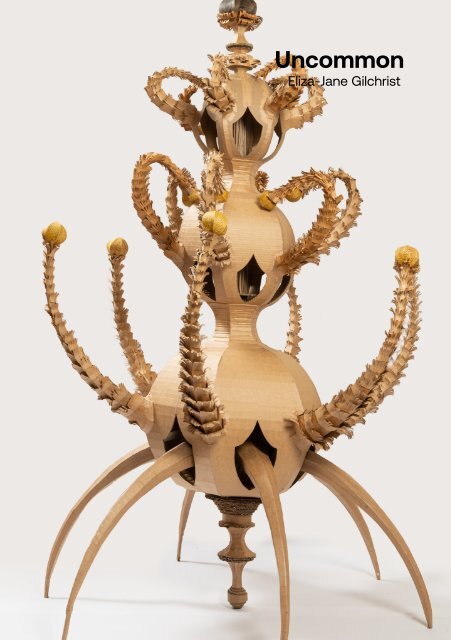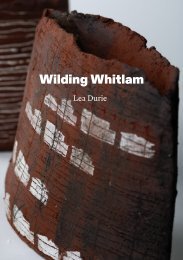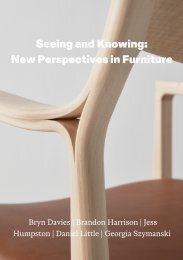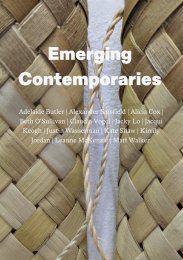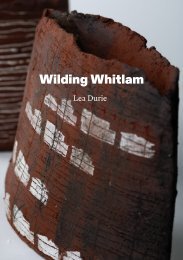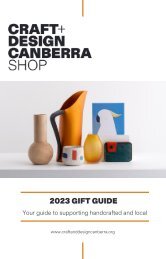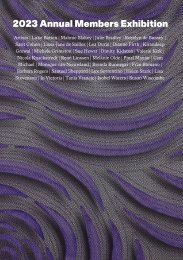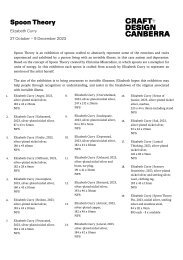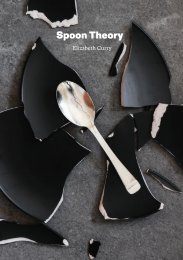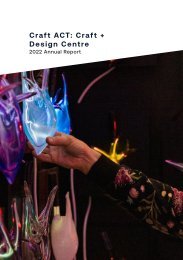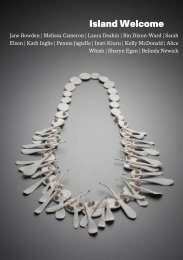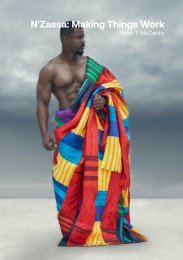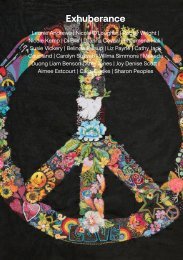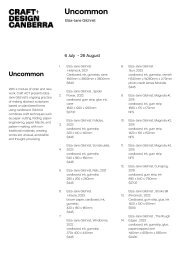Uncommon Exhibition Catalogue
Uncommon Eliza- Jane Gilchrist 6 July - 26 August 2023 CRAFT + DESIGN CANBERRA With a mixture of older and new work, Craft ACT presents Eliza-Jane Gilchrist's ongoing practice of making abstract sculptures based on plant/seed forms using cardboard. Gilchrist combines craft techniques such as paper-cutting, folding, paper-engineering, papier Mache, and pattern-making, with non-traditional materials, creating works are unusual, accessible and thought-provoking.
Uncommon
Eliza- Jane Gilchrist
6 July - 26 August 2023
CRAFT + DESIGN CANBERRA
With a mixture of older and new work, Craft ACT presents Eliza-Jane Gilchrist's ongoing practice of making abstract sculptures based on plant/seed forms using cardboard. Gilchrist combines craft techniques such as paper-cutting, folding, paper-engineering, papier Mache, and pattern-making, with non-traditional materials, creating works are unusual, accessible and thought-provoking.
Create successful ePaper yourself
Turn your PDF publications into a flip-book with our unique Google optimized e-Paper software.
<strong>Uncommon</strong><br />
Eliza-Jane Gilchrist
CRAFT + DESIGN CANBERRA is partially supported by the<br />
ACT Government, the Visual Arts and Craft Strategy - an<br />
initiative of the Australia State and Territory Governments,<br />
and the Australia Council for the Arts - the Australian<br />
Government's arts funding and advisory body.<br />
CRAFT + DESIGN CANBERRA acknowledges the<br />
Ngunnawal people as the tradition custodians of the ACT<br />
and surrounding areas. We honour and respect their<br />
ongoing cultural and spiritual connections to this country<br />
and the contribution they make to the life of this city and<br />
this region. We aim to respect cultural heritage, customs,<br />
and beliefs of all indigenous people,<br />
CRAFT + DESIGN CANBERRA<br />
Wednesday-Saturday 12-4pm<br />
Or by appointment.<br />
Level 1, North Building, 180 London Circuit,<br />
Canberra, ACT, Australia<br />
02 6262 9333<br />
www.craftact.org.au<br />
Cover Image: Eliza-Jane Gilchrist, Spider Flower , 2022 Photo: Lorena Carrington
<strong>Uncommon</strong><br />
Eliza-Jane Gilchrist<br />
6 July - 26 August 2023<br />
CRAFT + DESIGN CANBERRA
Image: Eliza-Jane Gilchrist, Relic, 2021 Photo: James McArdle
Image: Eliza-Jane Gilchrist, Storks Bill (Perched) 2022 Photo: James McArdle
Image: Eliza-Jane Gilchrist, Windborne, 2022 Photo: James McArdle
UNCOMMON<br />
Eliza-Jane Gilchrist<br />
With a mixture of older and new work, Craft + Design Canberra presents Eliza-Jane Gilchrist's ongoing<br />
practice of making abstract sculptures based on plant/seed forms using cardboard. Gilchrist combines<br />
craft techniques such as paper-cutting, folding, paper-engineering, papier Mache, and pattern-making,<br />
with non-traditional materials, creating works are unusual, accessible and thought-provoking.
Image: Eliza-Jane Gilchrist, The Rough Edges, 2023 Photo: James McArdle
Image: Eliza-Jane Gilchrist, Scrobiculate, 2023 Photo: James McArdle
Image: Eliza-Jane Gilchrist, Currajong, 2019 Photo: Lorena Carrington
UNCOMMON<br />
By Dr. Caren Florence<br />
At first glance these crafted organic shapes are pure<br />
fantasy, a deliberate transformation from their angular box<br />
origins, but there's no attempt to disguise the dun brown<br />
colour of industrial cardboard. Combined with black notes,<br />
the brown grounds everything, connects us back to earth.<br />
It's a minimalist palette that supports the maximalism of<br />
Gilchrist's imagination.<br />
Eliza-Jane Gilchrist is a visual and performance artist<br />
based in regional Victoria, who immigrated to Australia<br />
from the UK in 2009. Part of her practice is puppetry,<br />
which is unsurprising once we encounter her sculptural<br />
work. It could easily be read as theatrical props for the<br />
kind of story where the natural world triumphs over the<br />
reckless damage of our rampant industrial complex. The<br />
kind of story that saves everything with a beating heart.<br />
The large-scale works vacillate between longing to<br />
escape and staying to fix the problem. Trees bend into<br />
boats, architectural elements look responsible at first<br />
glance, legs want to spike down but then tentacle away,<br />
launching into flight. Gilchrist has the skills of a furniture<br />
maker, making the most of materials that are usually an<br />
afterthought once you've unpacked a piece of furniture<br />
that probably won't last your lifetime.<br />
Her titles can shift us away from fantasy into science: what<br />
I first saw as a tilting hat-stand reveals itself as a 'Burr'<br />
(2023), a sticking point writ large. It is caught on the wind,<br />
ready to burrow and itch into the even larger problem it<br />
lands upon: what is to be done about the problems we<br />
have created?<br />
Suddenly, it actually is that story where the natural world<br />
triumphs, whether we're looking at everyday shapes or<br />
objects that are wildly uncommon and therefore<br />
immensely precious. Seed pods, leaves, bark: all these<br />
shagged and pitted surfaces, often microscopic and<br />
unable to be seen or felt, are revealed via these<br />
transformed shards of waste. They radiate notions of<br />
usefulness, rehabilitation, celebration of difference.<br />
So much of this work seems to be built from a dream<br />
state of drawing: the doodles we do when half thinking,<br />
half-listening, the kind where solutions swim to the<br />
surface. They are manifest in the imagination of the built<br />
shapes and the lush drawn embellishments: fractals,<br />
connectors, camouflage marks, patterns-making,<br />
biological enhancements: she is creating strange new<br />
beasties from overlooked 'dead' materials.<br />
Not that paper (or card) is utterly dead: its capacity to be<br />
repurposed is remarkable. It also bears scars: a mark,<br />
once made on its surface, cannot be removed except by<br />
covering, disguising or repulping. If we can overcome our<br />
obsession with perfection and newness, Gilchrist<br />
suggests, maybe we can make do with what is already<br />
there. Her more recent works feature hollows, which are a<br />
more poetic form of holding than the capacity of sharpsided<br />
containers calculated to hold precise numbers of<br />
manufactured objects. A hollow is always ready for a few<br />
somethings that may shift, wriggle, grow, time-share and<br />
re-use.<br />
Gilchrist's skill and imagination shifts us outwards and<br />
inwards from things that we already know, things we need<br />
to constantly revisit, and encourages us to open ourselves<br />
to greater change – a badly needed change. Bring a child<br />
with you, if you can, to experience the full effect of her<br />
serious playfulness.<br />
Dr Caren Florance is an artist, designer, writer and<br />
creative researcher. Her practice is informed by material<br />
bibliography and book history. She works predominantly<br />
with text, often collaborating with artist and publishers.<br />
By using traditional letterpress and bookbinding<br />
processes along with more contemporary technologies,<br />
she produces diverse works across the book arts<br />
spectrum, from zines, artist books and installation work<br />
to formal publishing outputs. She is collected by national<br />
and international institutions (mostly libraries) and private<br />
collectors. Her most recent commercial volume is Lost in<br />
Case (Cordite Books, 2019). She is currently an Adjunct<br />
Assistant Professor with the University of Canberra<br />
Centre for Creative and Cultural Research (CCCR) and<br />
lives in Yuin Country.
Image: Eliza-Jane Gilchrist, Hollyhock, 2021 Photo: James McArdle
Image: Eliza-Jane Gilchrist, 2023, Burr Photo: James McArdle
Eliza-Jane Gilchrist<br />
ARTIST STATEMENT<br />
I work with cardboard to investigate our relationship with<br />
nature and to question what we value.<br />
I look at the garden, a place of familiarity, and find the<br />
strange shapes and patterns within it. I like to discover<br />
remnants of growth; seeds, seedpods, roots. Tiny things<br />
that are easily overlooked. Elements of these forms I<br />
abstract, re-combine and build at a different scale. The<br />
resulting sculptures combine architectural references,<br />
landscape features and plant and insect elements that<br />
are familiar yet strange in these new configurations. These<br />
sculptures show the wonder of the microscopic or minute<br />
and draw attention to repetitive patterns and complex<br />
forms.<br />
ARTIST BIOGRAPHY<br />
Eliza-Jane Gilchrist is a sculptor and performance maker<br />
based in Central Victoria, on DjaDja Wurrung country. In<br />
Eliza-Jane's sculpture practice her materials are often ugly,<br />
worthless things, which she tries to rehabilitate through<br />
hand-made alterations, embroidery or drawing, to<br />
challenge perceptions about what we value.<br />
I build these sculptures in cardboard because it is<br />
manufactured, it is ubiquitous, not inherently beautiful and<br />
is considered 'rubbish'. Cardboard is what we turn trees<br />
into; it is dead organic matter. I imagine that it has a<br />
cellular memory of being a plant and wants to reform into<br />
these organic shapes: it remembers being a plant.<br />
I draw on to the surface to transform the cardboard<br />
further, lavishing detail onto the bland, flat brown. These<br />
sculptures are memorials to plants that once were.<br />
In its role as packaging, cardboard is symbolic of the<br />
excessive consumption that is devastating the natural<br />
world. By re-packaging the packaging I suggest a reappraisal<br />
of what has value. These sculptures rehabilitate<br />
ugliness. They invest the mundane and insignificant with<br />
significance and beauty. The notion of packaging is<br />
extended into the new, hollow forms I create, they<br />
become more intricate boxes.
Image: Eliza-Jane Gilchrist, One Thing Leads Another,2019 Photo: Lorena Carrington
Image: Eliza-Jane Gilchrist, Magnolia 123 & Calyculus, 2016 Photo: Lorena Carrington
Image: Eliza-Jane Gilchrist, Magnolia 123 & Calyculus, 2016 Photo: Lorena Carrington
1 / Eliza-Jane Gilchrist, Magnolia #1, 2015<br />
cardboard, ink, gum strip<br />
1680 x 170 x 170 mm<br />
$445<br />
Eliza-Jane Gilchrist, Magnolia #2, 2015<br />
cardboard, ink, gum strip<br />
1420 x 150 x 150 mm<br />
$445<br />
Eliza-Jane Gilchrist, Magnolia #3, 2015<br />
cardboard, ink, gum strip<br />
1530 x 180 x 180 mm<br />
$445<br />
Eliza-Jane Gilchrist, Calyculus (cup-shaped structure), 2016<br />
cardboard, gum strip, ink<br />
1560 x 510 x 310 mm<br />
$675<br />
Eliza-Jane Gilchrist, Spider Flower, 2022<br />
cardboard, gum strip, glue, ink, cane<br />
1830 x 1220 x 1220 mm<br />
$2700
Eliza-Jane Gilchrist, Storks Bill (Perched), 2022<br />
Cardboard, gum strip, glue, ink<br />
1400 x 510 x 510 mm<br />
$590<br />
Eliza-Jane Gilchrist, Currajong 2018<br />
cardboard, gum strip, ink<br />
890 x 540 x 1750 mm<br />
$2700<br />
Eliza-Jane Gilchrist, One Thing Leads Another, 2019<br />
cardboard, gum strip, ink<br />
2000 x 1250 x 2160 mm<br />
$5400<br />
Eliza-Jane Gilchrist, Relic, 2021<br />
cardboard, ink, gum strip<br />
280 x 260 x 260 mm<br />
Eliza-Jane Gilchrist, Hollyhock, 2021<br />
cardboard, ink, gum strip, cane<br />
1900 x 3800 x 3800 mm<br />
$840
Eliza-Jane Gilchrist, Burr, 2023<br />
cardboard, ink, gum strip, varnish<br />
340 x 260 x 170 mm<br />
$445<br />
Eliza-Jane Gilchrist, Hirsute, 2023<br />
brown paper, cardboard, ink, gum strip<br />
420 x 180 x 180 mm<br />
$445<br />
Eliza-Jane Gilchrist, Windborne, 2022<br />
cardboard, ink, gum strip<br />
370 x 400 x 440 mm<br />
$445<br />
Eliza-Jane Gilchrist, Scrobiculate, 2023<br />
cardboard, ink, gum strip<br />
540 x 180 x 180 mm<br />
$445<br />
Eliza-Jane Gilchrist, The Rough Edges, 2023<br />
cardboard, ink, gum strip, glue, paper-wrapped wire<br />
1140 x 655 x 655 mm<br />
$2430
Eliza-Jane Gilchrist, Helianthus , 2023<br />
cardboard, ink, gumstrip, glue<br />
1280 x 550 x 550mm<br />
$1900<br />
Eliza-Jane Gilchrist, Follicles, 2023<br />
cardboard, ink, gumstrip<br />
320 x 140 x 140mm<br />
$445<br />
Eliza-Jane Gilchrist, Three-sided Capsule, 2023<br />
cardboard, ink, gumstrip, glue<br />
840 x 600 x 500mm<br />
$1100


